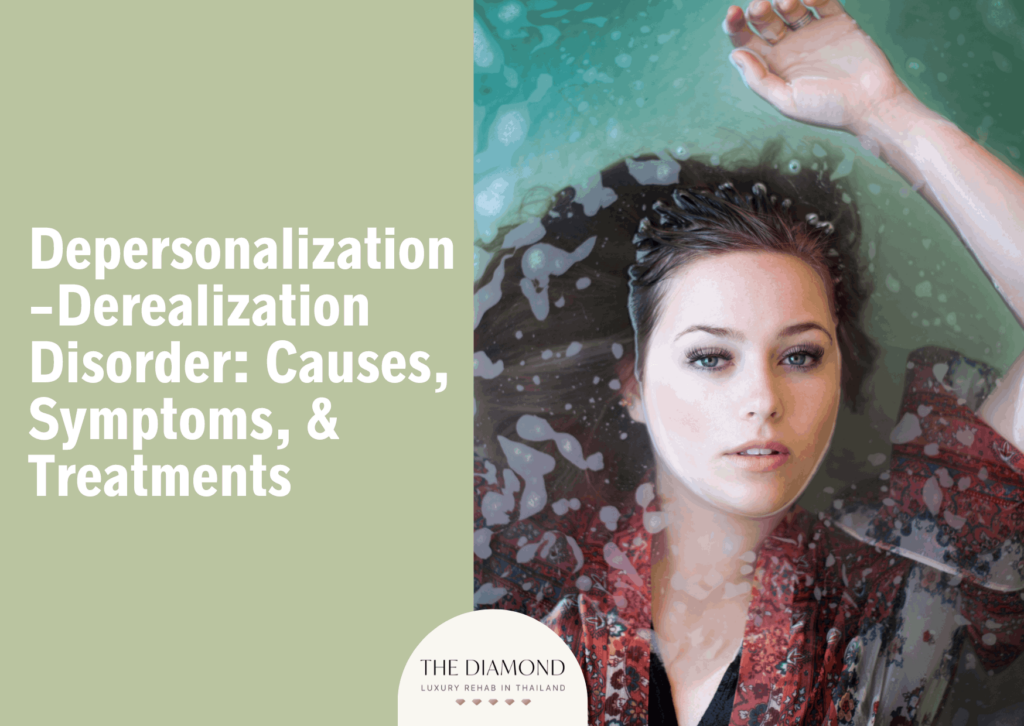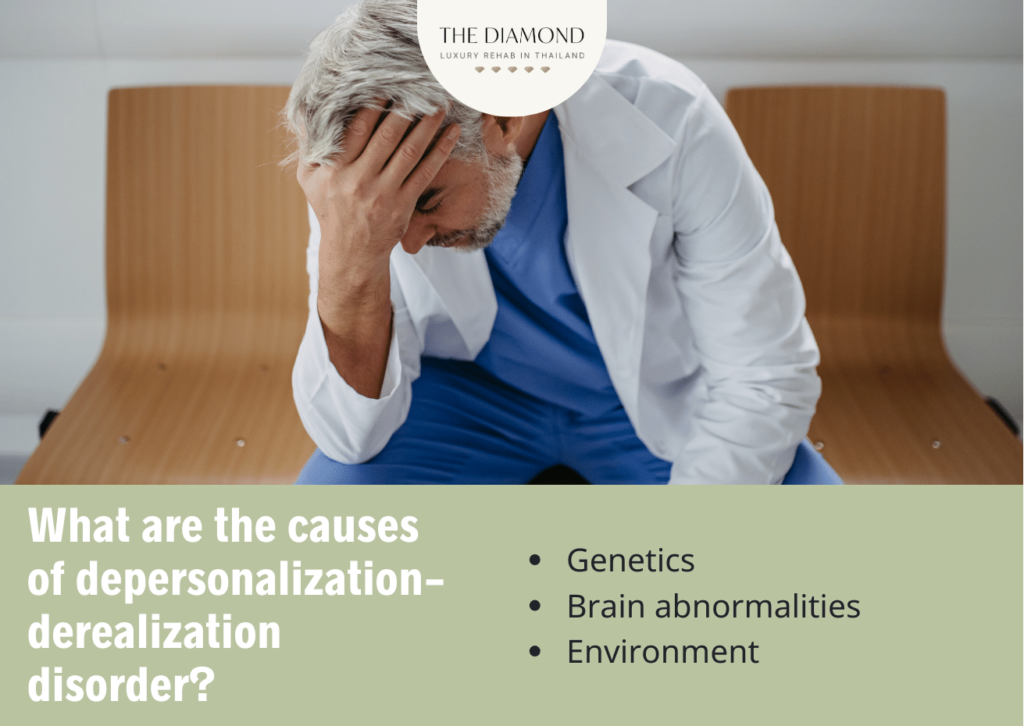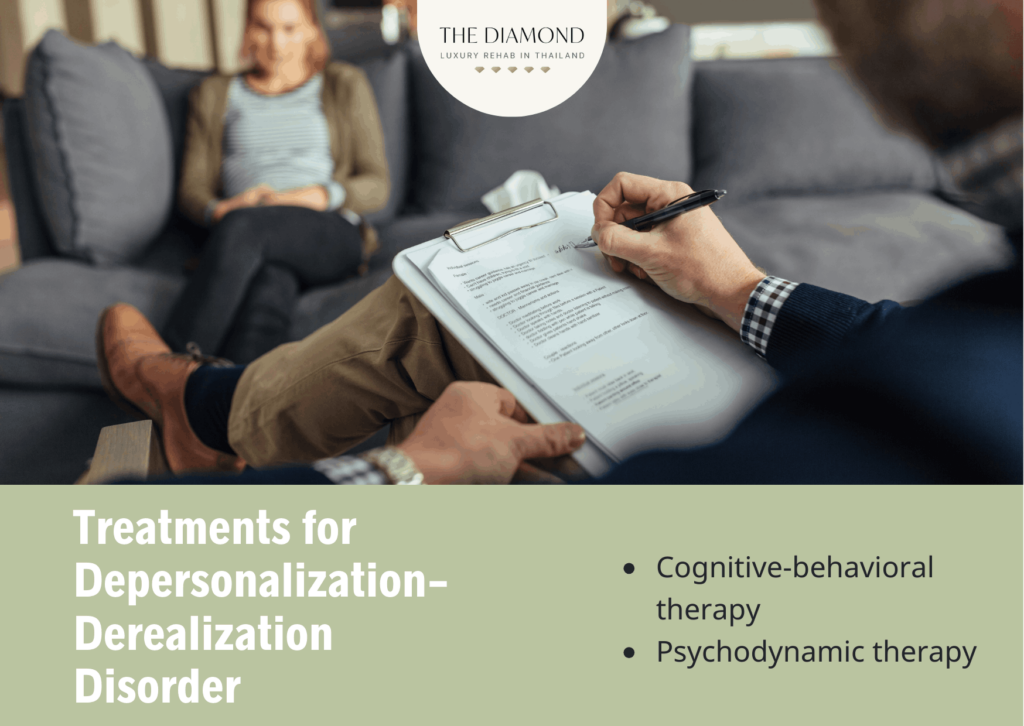Depersonalization-derealization disorder: causes, symptoms, and treatments
Table of content

Depersonalization-derealization disorder is a type of dissociative disorder indicated by feeling detached or disconnected from oneself and the surroundings. Most people have depersonalization or derealization at one point or another, but this mental health condition is more persistent and has a major impact on a patient’s quality of life.
The exact causes of the depersonalization-derealization disorder are still unknown. Dissociative disorders potentially have a genetic component, and this one isn’t an exception. For most patients, the main catapult for the depersonalization-derealization disorder is trauma.
They start disconnecting or dissociating to cope with intense emotions or traumatic experiences. Brain abnormalities and extreme stress additionally contribute to the development of this disorder.
The main symptoms of the depersonalization-derealization disorder include not feeling connected with oneself and the surrounding, being unable to attach emotions to memories, having an impaired sense of time, or feeling like limbs are distorted. People with this disorder don’t feel like they are in control of their emotions and aren’t familiar with their surroundings.
The main therapy approaches for the management of depersonalization-derealization disorder are cognitive-behavioral therapy and psychodynamic therapy. A few others don’t need treatment for depersonalization-derealization disorder, but several patients do.
What is depersonalization-derealization disorder?
Depersonalization-derealization disorder (DPDR or DDD) is a mental health disorder characterized by periods of feeling disconnected or detached from oneself (depersonalization), physically or mentally, or having a decreased sense of reality (derealization).
A person with DPDR repeatedly or persistently has the feeling that they’re observing themselves from outside of their body, or they feel like things around them aren’t real. At times, both scenarios are involved.
Most people experience depersonalization and derealization at a certain point in their lives. However, in people with DPDR, these feelings don’t go away, and they affect daily functioning.
In addition, certain people experience depersonalization and derealization as a symptom of other mental health disorders and physical conditions such as seizures. They don’t necessarily have DPDR. When depersonalization and derealization occur independently of other physical or mental health disorders and impair a person’s function, that’s when DPDR is present.
Depersonalization-derealization disorder is classified as a type of dissociative disorder in the Diagnostic and Statistical Manual of Mental Disorders, fifth edition (DSM-5) by the American Psychiatric Association. Generally speaking, dissociative disorders are characterized by feelings of disconnection from reality.
The average age of onset of DPDR is 16, as per a review by Daphne Simeon published in the 2004 issue of CNS Drugs. However, it is possible for the condition to begin during childhood too.
A 2023 review by Rachael J. Murphy published in the Innovations in Clinical Neuroscience added that only 5% of cases begin in adults over the age of 25, and incidence beyond the age of 40 is uncommon.
How common is depersonalization-derealization disorder?
Depersonalization-derealization disorder is not common, with an estimated prevalence rate of around 1% of the overall population, as per a paper by Yang et al., from the June 2022 issue of the Journal of Trauma and Dissociation.
The paper analyzed 23 studies categorized into three groups such as general population, outpatient, and patients with specific disorders. Findings additionally showed the prevalence of DPDR in outpatient samples was 5% to 20%, and for inpatients, 17.5% to 41.9%.
When it comes to specific disorders, the prevalence of DPDR among persons with substance abuse was 1.8% to 5.9%, anxiety 3.3% to 20.2%, other dissociative disorders 3.7% to 20.4%, schizophrenia 16.3%, borderline personality disorder 17%, and depression 50%.
The highest prevalence rates were observed among people who experienced interpersonal abuse, between 25% and 53.8%. Depersonalization-derealization disorder affects males and females equally.
Speaking of the prevalence of DPDR, it is important to mention transient depersonalization and derealization are quite common. Those are the situations when people experience detachment from themselves or reality briefly and are not a part of the disorder itself. Not every individual who experiences depersonalization and derealization has DPDR as a specific disorder.
What are the causes of depersonalization-derealization disorder?

The causes of depersonalization-derealization disorder involve various elements that play a role in the development of the condition. The potential causes of depersonalization-derealization disorder are listed below.
- Genetics: Certain people have a genetic predisposition to develop dissociative disorders, including DPDR. Further research is necessary to identify specific genes implicated in the development of this disorder.
- Brain abnormalities: Changes in aspects of brain structure and functioning contribute to the development of DPDR as well. For example, depersonalization is linked to reduced grey matter volume in the right thalamus (body’s information relay station), cuneus (involved in basic visual processing), and caudate (helps process visual information and regulate movement), and increased grey matter volume in left dorsomedial PFC (integrates social impressions from faces and verbal descriptions) and right somatosensory regions (receives tactile information from the body). There is evidence linking these regions to dissociation, a 2017 paper by Krause-Utz et al., published in Current Psychiatry Reports explained.
- Environment: A person’s environment greatly contributes to the development of depersonalization-derealization disorder. For example, children cope with growing up in a dysfunctional family or abusive and violent home by dissociating themselves from reality. This leads to symptoms of depersonalization and derealization.
- Traumatic experience: Children or adolescents cope with traumatic experiences by detaching or disconnecting from themselves and their surroundings.
- Severe emotional stress: Heightened stress triggers episodes of DPDR the same way as trauma i.e., the affected individual doesn’t process stress in a healthy manner. Instead, the single way for them to cope with severe emotional stress is to detach or disconnect.
What are the symptoms of depersonalization-derealization disorder?
Symptoms of depersonalization-derealization disorder cause significant distress or impairment in social, occupational, or other important areas of life. The symptoms of depersonalization-derealization disorder are listed below.
- The feeling of being an outside observer of your thoughts/feelings or disconnected from the whole or a part of the body
- Inability to attach emotions to memories or to understand those memories are experiences that happened to you
- The feeling of not being in control of movements or speech i.e. feeling robotic
- Alexithymia i.e., being unable to recognize and describe emotions
- Physical or emotional numbness of responses to the environment
- The sense that the head is wrapped in cotton
- Feeling like legs and arms are distorted, shrunken, or enlarged
- Feelings of being unfamiliar with surroundings or alienated from them e.g. like you’re living in a movie
- Distortion of size, shape, and distance of objects
- Impaired perception of time
- Feeling emotionally detached from family members and loved ones
- Surroundings appear distorted, colorless, blurry, and artificial
- Amplified awareness of surroundings
What effects does depersonalization-derealization disorder have on a person’s life?

The effects of depersonalization-derealization disorder are frightening and disabling for a person’s life, particularly when the disease is unmanaged. People with DPDR experience difficulty remembering things or focusing on tasks. The disorder interferes with daily routines and even with their work.
The effects of depersonalization-derealization disorder extend to problems in relationships with family and friends. People with this disorder often develop other mental health disorders, such as anxiety and depression. They gain a sense of hopelessness and it becomes difficult to handle the episodes.
When a person is disconnected from themselves or reality, their relationship with the world around them is greatly affected. For that reason, they struggle to complete tasks, which leads to impaired productivity at work.
That additionally explains why they aren’t able to do certain things in their daily routine. This disconnection leads to problems with other people, especially because a person becomes numb to the environment.
What are the risk factors for depersonalization-derealization disorder?
Risk factors for depersonalization-derealization disorder refer to the conditions or situations that put a person at risk of developing or experiencing the symptoms of depersonalization-derealization disorder (DPDR). The risk factors for depersonalization-derealization disorder are listed below.
- Having severe prolonged depression or anxiety with panic attacks
- Experiencing severe trauma during childhood (or rarely as an adult) such as being emotionally or physically abused and neglected
- Family history of severe mental illness or other form of impairment (especially parent)
- Witnessing traumatic events such as domestic violence
- Having personality traits that make you want to avoid or deny difficult situations or that make it difficult to adapt to stressful occasions
- Severe, unmanaged stress
- Recreational drug use (especially marijuana, ketamine, or hallucinogens)
- Death of a family member or close friend
How is depersonalization-derealization disorder diagnosed?
Depersonalization-derealization disorder is diagnosed after a physical exam and psychiatric evaluation. The main goal of a physical exam is to determine whether the symptoms stem from a specific health problem. In addition to a physical exam, a doctor orders lab and imaging tests.
When physical exams and lab tests don’t show the presence of a health problem, a doctor refers a patient to a mental health professional. They are going to perform a psychiatric evaluation. During which, a psychiatrist asks the patient about their symptoms, feelings, thoughts, and behaviors.
The doctor diagnoses depersonalization-derealization disorder when a patient meets the criteria from DSM-5. These criteria include persistent/recurrent episodes of depersonalization, derealization, or both, believing what a person feels isn’t real, and experiencing significant distress and impairment in social and occupational functioning due to the symptoms.
What are the treatments available for depersonalization-derealization disorder?

Treatments available for depersonalization-derealization disorder involve various therapeutic approaches aimed at managing and alleviating the symptoms of depersonalization-derealization disorder (DPDR). The most common treatment approaches for DPDR are listed below.
- Cognitive-behavioral therapy
- Psychodynamic therapy
1. Cognitive behavioral therapy
Cognitive-behavioral therapy (CBT) is a type of psychotherapy that helps patients recognize negative or unhelpful thought and behavior patterns. As a structured, goal-oriented talk therapy, CBT enables patients to replace those negative or irrational thoughts with more realistic or positive alternatives. This positively influences their emotions and mood.
Therapists use CBT to help patients with various mental health problems and depersonalization-derealization disorder is among them. In the treatment of DPDR, cognitive-behavioral therapy works by helping patients reframe their thoughts, change negative or harmful thought patterns, identify triggers, and set goals to work through them.
In the process of changing irrational or negative thoughts, CBT teaches patients to challenge them. This is done to show that many thoughts and beliefs aren’t based on logic. Since a person doesn’t have an argument to support them, the intensity of these thoughts lessens. That way, it becomes easier to decrease or eliminate negative emotions or behaviors these thoughts usually cause.
A 2005 study by Hunter et al., from Behaviour Research and Therapy found that CBT is an effective treatment for depersonalization disorder. In addition to lowering avoidances, safety behaviors, and symptom monitoring, the therapy entailed assisting the patients in reinterpreting their symptoms in a non-threatening manner.
Participants experienced improvements in several aspects of the condition, including anxiety, depression, dissociation, and general functioning.
During CBT sessions, patients learn coping skills and other skills depending on their symptoms. For example, if a person doesn’t communicate well with family or other people due to their DPDR, they need to learn communication skills. Patients additionally get homework so they have the chance to practice the skills they learned between the sessions.
2. Psychodynamic therapy
Psychodynamic therapy is a therapy whose main focus is the psychological roots of emotional suffering. The main aspects of psychodynamic therapy are self-examination and self-reflection. Through psychodynamic therapy, patients get a deeper understanding of their emotions and mental processes.
As people understand how they feel and think, they’re able to make better choices and improve relationships with other people. This therapy is particularly beneficial for patients with DPDR because it helps them repair relationships with family and friends.
In addition, patients understand their motivations better, which is important because DPDR patients are generally disconnected from themselves. Since they’re disconnected from themselves, patients with this disorder don’t understand their emotions, memories, or motivations.
Psychodynamic therapy for DPDR works because it allows patients to work through conflicts or feelings that they detach from.


